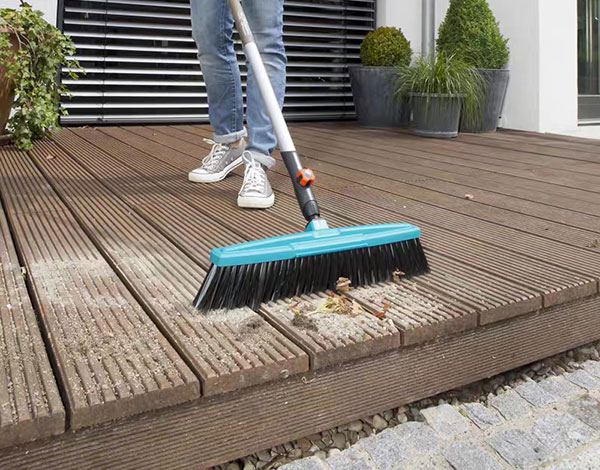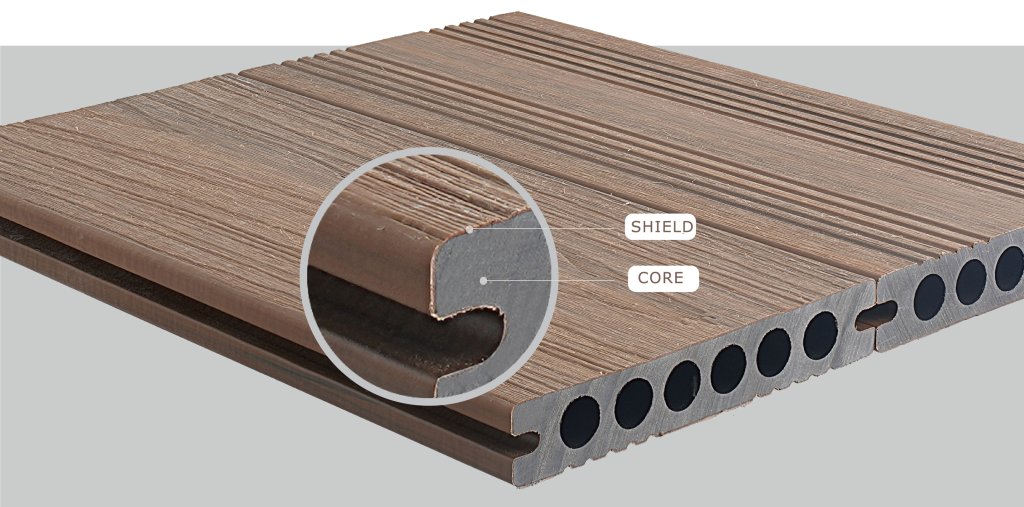Everything exposed to outdoor elements requires proper maintenance – and composite decking is no exception. While marketed as low-maintenance, understanding proper composite decking maintenance is crucial for protecting your investment and ensuring its longevity.
Essential Composite Decking Maintenance Procedures
Regular Cleaning Routine
For effective composite decking maintenance, follow these cleaning guidelines:
1.Pressure washing
Pressure washer can be used to clean composite decking. Make sure the pressure washer is no greater than 8Kpa (1200 psi), and you must keep a distance of at least 30cm from the deck surface as this may mark the surface of the deck.

2.Daily Maintenance
Sweep off deck to remove dirt and debris. Routine sweeping with a firm bristled broom is often the most effective way to remove small debris from the deck surface. This also helps keep the spaces between each deck plank open to allow rain water to drain off the deck more easily too. If necessary, you can use warm, soapy water with a scrub brush to gently remove stubborn spots.

Common Maintenance Challenges and Solutions
Dealing with Different Types of Stains
1.Water stains
There will be some water stains on the surface of the newly installed terrace when the water evaporates. It is temporary phenomenon which will disappear in about 1-2 months by itself.
2.Oil and grease stains
Composite decking is susceptible to stains from food oil, grease and tannin in some vegetation. Best results are achieved if the stain is treated immediately with absorbent cloths, and then apply a commercial deck cleaner or degreaser. Be sure test in an in conspicuous area prior to cleaning the entire deck. Follow up with a general clean with warm and soapy water.
Please note that never use a cleaner that contains bleach as this could permanently discolor the deck surface.
3.Scratches or surface abrasions
Markings of this type should fade with weathering, and the machined finish and embossed pattern on the surface is possible to hide most minor scratches. For larger scratches, you can also remove the scratches with sandpaper, following the grain of the board, please note that over sanding of your deck boards can remove the embossed pattern.
We recommend using a protective mat or pads to prevent contact from items such as furniture legs, BBQ’s stands etc.
4.Ice and snow
Use calcium chloride or rock salt to melt the snow and ice from the deck surface.
5.Mold and mildew
Mold & mildew are commonly found on outdoor building materials. To prevent pollen and debris buildup, periodic cleaning is best. If mold/mildew is present, use warm soapy water made with mild dishwashing detergent and a soft sponge/rag to remove. Thoroughly rinse off with a garden hose when complete.
Commercially available deck cleaners or detergents can be used, make sure that you follow the manufacturer’s recommendations for use and always test the solution in a conspicuous area of your deck first. Follow up with a general clean with warm and soapy water.
Advanced Maintenance for Capped Composite Decking
For uncapped composite decking, the wood component within WPC does impact some positive attributes compared to plastic, the inherent problems with wood (moisture sorption and susceptibility to mold and decay) remain. Bongywood Capped Composite Decking is inherently more resistant to damage from moisture, mold and mildew growth, performing better than any traditional composite.
Understanding Bongywood Capped Composite Structure
Bongywood Capped Composite Decking is composed of core and cover. It has an advanced tough plastic shield encasing all four sides around its inner WPC core. As a result, they were far more vulnerable to staining and fading. Capped composite decking, known for its low-maintenance characteristics, still requires some care to remain in pristine condition:
PROTECTIVE SHIELD
Capped composite decking refers to the protective outer layer or cap that is typically made of a high-performance polymer. This cap shields all four sides around its inner WPC core from the elements, making the decking even more resistant to staining, fading, and general wear and tear.
COMPOSITE CORE
The core is from Bongywood wood plastic composite materials, which uses recycled plastic and recycled wood.
Professional Maintenance Tips
- Regular Cleaning: Recommend homeowners clean their capped composite decks periodically, usually with a mild soap and water solution or a specialized composite deck cleaner. This removes dirt, debris, and any surface stains.
- Addressing Stains: While capped decking is highly stain-resistant, spills should be addressed promptly. Most stains can be removed with a simple cleaning regimen.
- Mold and Mildew: In damp, shaded areas, mold and mildew can develop. A thorough cleaning can prevent this issue, but in persistent cases, a specialized mold and mildew cleaner may be necessary.
Bottom Line
So, while composite decking maintenance is significantly lower compared to traditional wood decking (no staining or sealing required), it’s not completely maintenance-free. Regular cleaning and some attention to potential issues are necessary to keep your WPC decking looking good and performing well over the long term. And choosing the best composite decking material can make a deck easier to take care of than others. Typically, the better-quality composite decking products will also have a longer lifespan.
Bongywood Wood Plastic Composite
Guangdong Bongywood New Building Materials Co., Ltd. is a professional manufacturer specializing in the R&D, production, and sales of WPC (Wood Plastic Composite) materials, our products include composite decking, capped composite decking, WPC Wall Panel, WPC Railing & Fencing, WPC Pergola & Gazebo, WPC Chairs & Bench, WPC Flower Planter Pots, etc. Contact us today for professional expertise and a free quote.







